Nikon D5100
-
-
Written by Gordon Laing
Verdict
NEW: Nikon D5100 vs Canon T3i / 600D review
Nikon’s D5100 is a successful upgrade over one of the company’s most popular DSLRs. It may not be as significant an upgrade as the D7000 was over the D90, but there’s certainly a lot more to get excited about than many new products. As such, the D5100 becomes one of the most compelling upper-entry-level DSLRs on the market, fulfilling its brief to offer a decent step-up from a budget model without encroaching on the sophistication and price of a mid-range or semi-pro body.
The D5100’s improvements over its predecessor are concentrated around four headline specifications: first it inherits the excellent 16 Megapixel sensor of the D7000, secondly, it upgrades the size, resolution and hinge mounting of its screen, third, it borrows the core movie capabilities of the D3100 and D7000, while also offering an external microphone input and broader selection of frame rates at 1080p, and fourth, its new EFFECTS mode applies a choice of fun filters, some of which also work on movies. The much preferable side-hinging for the screen has also eliminated the earlier D5000’s disproportionately tall viewfinder head, allowing Nikon to design a shorter and curvier body for the new model.
If you were hoping for faster continuous shooting, improved AF, tougher build or a bigger viewfinder, you’ll be disappointed, but by offering the D7000’s quality at a lower price point with an excellent flip-out screen and a broader selection of 1080p frame rates, there’s a great deal to like here. The D5100 is destined to become another best-seller for Nikon, although as discussed in detail throughout the review, its rival from Canon has never been closer.
| 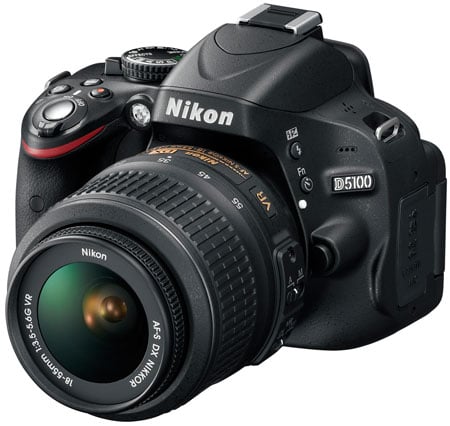 |
Before making comparisons with the models above and below it in the Nikon range, along with Canon’s EOS 600D / T3i, I’ll take a closer look at the headline specifications, starting of course with image quality.
By inheriting the same sensor and image processor as the D7000, there aren’t many surprises concerning the D5100’s photo quality. Like the D7000, the images are very naturally processed, maximising detail without compromising on over-cooked artefacts. Like earlier models, in-camera reduction of coloured fringing delivers very clean-looking results compared to the competition, and as you can see in my results pages, there’s certainly little to no benefit to the extra two Megapixels of the Canon EOS 600D / T3i. Indeed in terms of noise levels, the D5100 enjoys the edge at the highest sensitivities, although again they’re roughly neck-in-neck at the most common sensitivities up to 800 ISO.
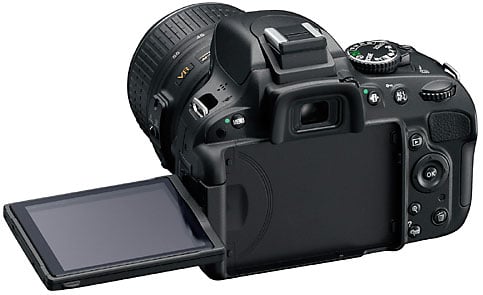 |
The biggest physical change to the D5100 over its predecessor concerns the screen. Nikon’s made a significant upgrade here, swapping a basic 2.7in / 230k panel for a larger and much more detailed 3in / 920k monitor, and moving the hinge from the bottom to the side. While the relocated hinge means there can sometimes be tangles from a strap, I ultimately much preferred its new position. On the earlier D5000, the bottom-mounted hinge just didn’t feel intuitive in operation, and crucially didn’t allow the screen to be turned to the subject while mounted on a tripod or resting on any surface. By following Canon and Panasonic to a side-mounted hinge, the D5100’s screen simply becomes much more usable. Of course the hinging is a moot point if you don’t compose with Live View or film movies, but for those who do, even if only occasionally, the new side-mounting is a major upgrade. Meanwhile, everyone benefits from the larger, higher resolution screen itself.
The D5100’s movie mode is a world apart from its predecessor, which only offered one HD movie mode at 720p / 24fps with manual focus and no mic input. Now the D5100 inherits the continuous autofocusing and external microphone input of the D7000, while expanding on its frame rates with a choice of 720p and 1080p at 24, 25 or 30fps. Annoyingly unlike the D7000 there’s no definitive manual exposure control, with the D5100 instead following predecessors by adopting the last f-number set before entering Live View, and leaving the shutter speed automatic at all times. But on the plus side, you do get a selection of EFFECTS filters which can be applied to movies, including selective colour and miniature tilt-shift options. Like the D7000 and D3100 before it, the continuous autofocus is a brave attempt at getting round the limitations of a traditional DSLR, but audible and visibly distracting searching may force you to turn it off more often than not.
The new EFFECTS mode may seem like a novelty at first glance, but proves to be genuinely fun, and much more useful than Canon’s post-capture options as the D5100 can apply them during composition and in some cases when filming video too. Funnily enough, the least compelling EFFECT mode for me personally was the much-touted Night Vision option which operates at up to 102,400 ISO. This setting really can capture an image under extremely dim conditions, but suffice it to say the quality ain’t pretty and you’ll also struggle to focus under the kind of lighting which justifies a sensitivity of over 100,000 ISO.
As mentioned above, there’s essentially no change in continuous shooting speed, AF system or viewfinder size from the D5000; indeed in one respect the viewfinder has been downgraded as it no longer offers the unique and useful on-demand LCD grid lines of its predecessor. Enthusiasts will also be dismayed to discover Nikon’s kept the user interface essentially unchanged, which means the minimum of dedicated buttons coupled with often laborious numbers of presses to get to the settings you want.
The D5100’s usability, not to mention that of the D3100, could be greatly improved by adopting the clean grid-like settings interface of Canon and Olympus, without compromising beginner-friendliness, but it’s becoming clear Nikon has no intention of indulging more sophisticated (or perhaps impatient) owners with its sub mid-range models. It’s also important to remember while Nikon is clearly aiming for simplification with minimal button labelling, there are in fact roughly the same number of controls on the D5100 as the Canon EOS 600D / T3i, so it’s arguably no more approachable.
Indeed there’s a feeling which pervades the more you use the D5100. It may on the surface appear similar in sophistication and control to rivals like the EOS 600D / T3i, but look a little deeper and you’ll notice a number of things which could irritate more advanced owners over time: direct access to only one popular setting with a single function button, a pointlessly laborious user interface, the absence of ISO always shown in the viewfinder, no live histogram, lack of a depth-of-field preview, no output for external monitors once you start filming, no built-in AF motor to drive older lenses and 720p video at frame rates which prevent smooth slow motion playback. To be fair, none of these will bother the target audience of beginners or those who want a step-up from entry-level models, but like its predecessor there’ll also be a number of enthusiasts who go for the D5100 and could become annoyed by some of its omissions over time. Revealingly most of these aspects are also addressed by it biggest rival, which brings me to the comparisons.
Compared to Nikon D3100
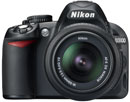 | ||
Nikon’s D3100 is the model below the D5100: it’s Nikon’s entry-level DSLR, but don’t be fooled by its position and lower price, as it shares a number of aspects with the higher-end model including 1080p video recording with continuous autofocus and an 11-point AF system. Indeed it’s one of the best-featured entry-level DSLRs on the market.
In its favour, the higher-end D5100 features two extra Megapixels, a fully-articulated screen that’s also much more detailed (921k dots versus 230k), continuous shooting that’s one third quicker (4fps vs 3fps), 1080p video recording at a choice of 24, 25 or 30fps as oppose to just 24fps, an external microphone input, a series of effects which can be applied at the time of shooting, and support for optional infra-red remote control.
While you’d expect the higher-end D5100 to sport all the advantages, it’s not a completely one-sided argument. The D3100 is a little smaller and lighter, while also sporting a GUIDE mode on the dial which literally guides you through taking various types of photos with as little or much help as you desire.
This coupled with the more compact dimensions and cheaper price make it the preferred choice for DSLR beginners. And again while the D5100 will ultimately be preferred by movie makers or enthusiasts who can’t stretch to the D7000, the D3100 remains one of the most powerful and compelling entry-level DSLRs on the market.
See our Nikon D3100 review for more details.
Compared to Nikon D7000
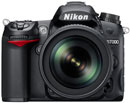 | ||
Nikon’s D7000 is the model above the D5100 in the range; technically speaking the older D90 actually squeezes in-between both these models, but this is essentially a discontinued model that’s enjoying a stay of execution thanks to extended demand or supply. The newer D7000 is Nikon’s official mid-range DSLR, although one at the top-end of that category with many semi-pro features. The D5100 may share the same 16 Megapixel sensor and 3in VGA screen panel, but the D7000 is a more sophisticated and powerful camera.
Physically the D7000 is a larger camera. The D5100 may actually be 2mm thicker due to its articulated screen mounting, but the D7000 is 4mm wider and 8mm taller, not to mention 220g heavier when both are fitted with their respective batteries. The D7000 also employs magnesium alloy on its upper and rear plates for additional toughness. Some may prefer the smaller and lighter body of the D5100, while others will appreciate the chunkier D7000 with its additional heft – it certainly looks and feels like a more serious body without going to the greater size and weight of a true semi-pro model.
Some of the extra height and weight of the D7000 is down to its bigger and brighter penta-prism viewfinder, which boasts 100% coverage and 0.94x magnification for a broader and noticeably larger view. The D7000’s viewfinder also sports handy on-demand LCD guidelines which can be switched on and off in a menu.
Looking through the viewfinder you’ll also notice a much denser array of autofocus points: 39 in total compared to 11 on the D5100, and nine of which are cross-type sensors as oppose to just one on the D5100. The D7000 additionally offers AF Fine Tune facilities to correct for lenses which front or back-focus, and it also has a built-in AF motor to drive older non-AF-S lenses.
Continuous shooting is quicker at 6fps compared to 4fps, and impressively for a camera in its class, the D7000 also features not one but two SD memory card slots which can write JPEGs to one and RAW files to the other, or simply duplicate images on both cards for instant backup. The maximum shutter and flash sync speeds are 1/8000 and 1/250 (versus 1/4000 and 1/200), and the metering more sophisticated (2016 pixel sensor vs 420 pixel sensor). The D7000 also offers manual control over exposures for the movie mode, and finally, the kit includes the longer and better-built DX 18-105mm VR zoom compared to the basic DX 18-55mm VR on the D5100.
It’s not completely one-sided though. The D5100 boasts a fully articulated screen mounting, a new live effects mode, and also offers 1080p video recording at a choice of 24, 25 or 30fps, whereas the D7000 is fixed at 24fps. And again, the D5100 is smaller, lighter and cheaper. Both cameras also share essentially the same image quality.
If you intend to mostly film video, the D5100’s flip-out screen and variable 1080p frame rates will probably sway it for you, but if you value traditional photographic features, the more sophisticated D7000 will easily justify its higher price tag. It’s one of the most impressive mid-range DSLRs on the market and treads on the toes of many semi-pro models.
See our Nikon D7000 review and video demonstration for more details.
Compared to Canon EOS 600D / Rebel T3i
 | ||
The biggest rival to the Nikon D5100 is undoubtedly Canon’s EOS 600D / Rebel T3i. Both models were announced within two months of each other, share similar core capabilities including 1080p movies, articulated high resolution screens and microphone inputs, along with being roughly the same size, weight and price. To see the differences, you need to look closely at the specifications.
In its favour, the D5100 sports an 11-point AF system to the Canon’s nine, fractionally quicker continuous shooting of 4fps compared to 3.7fps, continuous AF while filming videos (albeit nothing like you’d get with a camcorder or a Sony SLT), a selection of special effects which can be applied while shooting or filming, a dedicated record button to start filming at any time, a maximum sensitivity of 25,600 ISO (along with a Night Vision mode at 102,400 ISO), in-camera HDR (albeit with only two frames), front and rear IR ports for an optional remote control (the Canon only has a front sensor), a built-in Intervalometer for automatic shooting, and a user interface that’s arguably better for beginners.
In its favour, the EOS 600D / T3i has wireless flash control, a slightly wider screen which matches the native shape of its images (avoiding letterboxing in playback or Live View), full manual control over exposures in the movie mode, digital zoom and video snapshot movie options, 720p movies at higher frame rates of 50 or 60fps (versus 24, 25 and 30fps), audio level meters and fine control over adjustments, a live histogram in Live View, direct access to ISO, White Balance, AF modes and more along with a quicker user interface, and a fractionally bigger viewfinder image which additionally shows the ISO value at all times.
In terms of image quality, the EOS 600D / T3i boasts 18 megapixels to its rival’s 16, but as we saw when comparing the D7000 against the EOS 60D, this makes little difference to resolved detail, and the Nikon enjoys a quality advantage at 3200 ISO and above.
Unlike the previous generations, the Canon and Nikon mid-range DSLRs are closer than ever before and if the minor differences in features don’t sway you, a lot will boil down to personal preferences in styling and brand loyalty.
For more details, check out our Canon EOS 600D / Rebel T3i review.
Nikon D5100 final verdict
As I said at the top of this page, the Nikon D5100 represents a decent upgrade over its predecessor, and while it lacks the manual movie exposure control of the D7000, the choice of multiple 1080p frame rates, live special effects and fully articulated screen arguably make it the company’s most confident and flexible movie-making DSLR to date. Certainly if your priority is filming video and you want a Nikon DSLR, the D5100 is the model to go for, even if you’ll probably disable its headline-grabbing continuous AF capabilities for most of your footage.
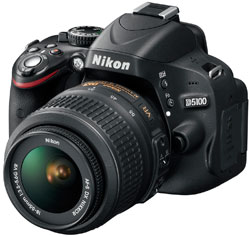 | |
If you’re a stills shooter, the D5100 offers less of an upgrade over its predecessor, but you are getting the D7000’s excellent 16 Megapixel sensor in a smaller, lighter and much more affordable body. You’ll also get a higher quality screen than the D5000 that’s easier to articulate for shooting at unusual angles, not to mention a selection of special effects which can be applied while you compose. But again if you’re looking for quicker continuous shooting, more sophisticated AF, tougher build or a bigger viewfinder from Nikon, you’ll need to step-up to the D7000.
Beginners or those on a budget looking for a step-up from an entry-level model are well-catered for: the D5100 is easy to use, while delivering excellent results for both photos and video. It may be lacking the ultimate hand-holding of the D3100, but context-sensitive help and a friendly, if laborious interface, ensure you get the results you want. The special effects are also fun to have.
Overall the D5100 is another very successful DSLR from Nikon, slotting perfectly between the D3100 and D7000 with solid features including great photo and video quality, and a fully articulated screen. Arguably its biggest failing is when it comes to catering to more advanced users, or those who’ve grown in sophistication over time. Viewed in isolation you’d be forgiven for wondering what the problem is, but shoot with the D5100 alongside the similarly-priced Canon EOS 600D / T3i and various differences become more apparent.
Most of them are focused on their respective movie modes, which on the Nikon is aimed more at beginners with continuous AF and special effects, compared to the Canon with 720p at 50 / 60fps for slow motion, proper manual control over exposures, audio level meters and the possibility of driving an external monitor while filming, even if only in standard definition. Indeed your preference for movie features may swing you towards one model over the other, but there’s no denying the D5100 will appeal more to beginners, whereas the EOS 600D / T3i has more for enthusiasts in this regard. Likewise when weighing-up the D5100’s EFFECTs mode and the EOS 600D / T3i’s wireless flash control, or their differences in controls and the user interface.
Don’t get me wrong, the Nikon D5100 is a DSLR I can Highly Recommend if you want a step-up from a budget model, fancy a relatively pain-free introduction to DSLR video, or simply desire the D7000’s quality at a cheaper price. But if you’re a more advanced photographer on a budget or especially a higher-end videographer, you’ll almost certainly prefer the more sophisticated pitch of the Canon EOS 600D / T3i.
For more details comparing these two rivals, see our Nikon D5100 vs Canon T3i / 600D video.
Nikon D5100 video samples
Here are a selection of sample videos filmed with the Nikon D5100 using its DX 18-55mm VR kit lens and best-quality 1080p / 30fps / High Quality movie mode. Registered members of Vimeo can download the original files by clicking the links below each window; these take you to the Vimeo page where the video is hosted and the link to download the actual file can be found under the ‘About this video’ section in the lower right.
| |
|---|---|
|
In my first clip above the first thing to notice is the lack of vertical streaking around the sunlight reflections on the water – this is a benefit of a camera with a CMOS sensor. But if you’re playing the file with audio, you’ll immediately hear a faint squeaking or scratching sound in the background every couple of seconds. This is the sound of the kit lens being refocused by the D5100’s continuous AF-F option, and it’s quite audible on this clip. Unfortunately in this example, the continuous autofocus isn’t doing a great job either, regularly searching for a subject with sufficiently strong contrast for it to lock onto. So while the actual video quality itself is fine, the continuous AF option hasn’t performed so well in this example; indeed disabling it produced a better result. This is exactly what we found on the earlier D7000 and D3100, but like those models, before you write-off the D5100’s AF-F mode, check the clips below as it can prove more effective under the right conditions. Note I also have versions of the clip above filmed in 24p and 25p. See our Nikon D5100 24p sample and Nikon D5100 25p sample.
| |
|---|---|
|
In the second clip, above, I’ve locked the D5100 to a tripod, disabled VR and AF on the kit lens and smoothly panned from left to right. With the Continuous AF disabled, it’s quite a relief not to hear the scratching sound of the kit lens focusing in the background, and it allows you to appreciate the quality of the video on the D5100. Like all DSLRs though, zooming smoothly, even on a tripod, is a challenge, but I’ve included several adjustments towards the end for reference. Watch out for the wind noise as I point the camera towards the steamship, and also the sound of a dog snoring in the background…
| |
|---|---|
|
Moving on, the third clip above was filmed handheld in a relatively dim bar with both VR and AF-F enabled. At first, the camera’s AF system seems happy not to make any adjustments, but around halfway through, it kicks-in and once again the scratching sound, not to mention the visual searching becomes quite distracting – epsecially towards the end when it has to perform a broad adjustment. Once again, this clip works much better with Continuous AF-F mode disabled. On the plus side, the clip itself may be noisier than those filmed outside, but the noise levels remain relatively low and the detail high. Obviously given a lens with a brighter focal ratio, the results in low light can look much better.
| |
|---|---|
|
The fourth clip, above, deliberately puts the new AF-F mode to the test. Here I moved the camera around, pointing it at various subjects near and far to see how the continuous autofocus coped. Give the D5100 some defined edges for its contrast-based AF system to lock-onto and it can actually do quite a good job. Sometimes the focusing searches a little, but at others it feels more confident as it locks-onto the desired subject. Indeed as the clip progresses, it’s hard not to be at least a little impressed by the AF-F mode as it succeeds more than it fails. It may not be as consistent as a consumer camcorder, nor as confident as the phase-change AF on the Sony Alpha A33, but the D5100 still manages to keep the subject mostly focused as the composition changes, while the ambient background sounds mostly mask the kit lens’s AF motor. This is an impressive capability for a camera that only has a contrast-based AF system at its disposal while filming (along with the challenges of a shallower depth-of-field than a camcorder); remember Canon’s DSLRs don’t even attempt to continuously autofocus while filming, making this clip impossible without constant manual adjustments.
| |
|---|---|
|
In the final clip, above, I’ve given the D5100 a more predictable subject to track with its continuous AF. I zoomed the kit lens to 55mm, adjusted the D5100’s AF area to the middle, and kept it positioned over the Skyline logo on the cable car as it steadily approached. Like most contrast-based AF systems, the D5100 searches back and forth as it attempts to lock-on, and this is quite visible at several points during the clip. This is undoubtedly off-putting, but to be fair, the D5100 does manage to keep the logo relatively sharp throughout the clip, even when it’s only a meter or so distant. Once again this is something which would have required constant manual focus pulling on a Canon DSLR. So while the D5100 continuous AF during filming may not live up to the experience of a consumer camcorder (nor the unique capabilities of the Sony Alpha A33), it remains a very impressive attempt given the available resources.
| |
|---|---|
|
In a first for any Nikon DSLR, the D5100 offers a number of special effects via a dedicated EFFECTS position on the mode dial. These all work for still photos, but some can also be applied to video. The first example, above, is for the Selective Color Effect, where you can sample one or more colours and adjust the tolerance, after which the D5100 turns everything else into black and white. Here I sampled the red hat on the bear and simply let the camera do the rest. It’s really nice to see this effect applied on video with zero effort, and it seems funny to think back this was a major and much talked-about effect on ‘Schindler’s List’ only a few years ago.
| |
|---|---|
|
Another one of the D5100’s special effects which can be applied to video is the Miniature option, an increasingly ubiquitous effect which simulates a tilt and shift lens for a toy-like appearance. This requires considerable processing, so can’t be captured in real-time at 24-30fps, but the D5100 uses this to its advantage and captures processed frames at a slower speed. Then when played back, they speed-up, further accentuating the miniature effect. Like still images, the Miniature effect can be applied with three different focus window thicknesses – here I used the middle option, and zoomed the kit lens in.





